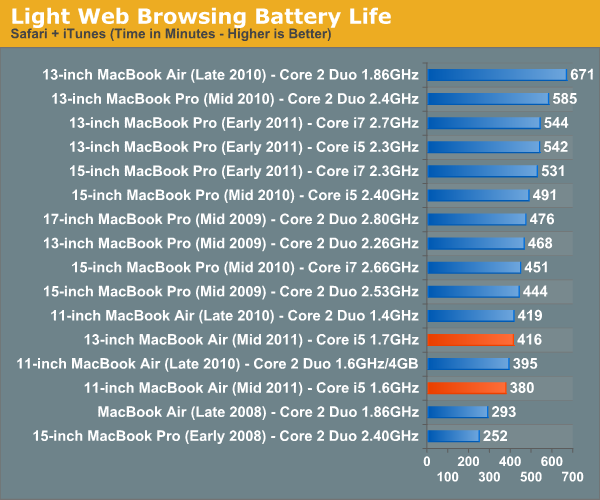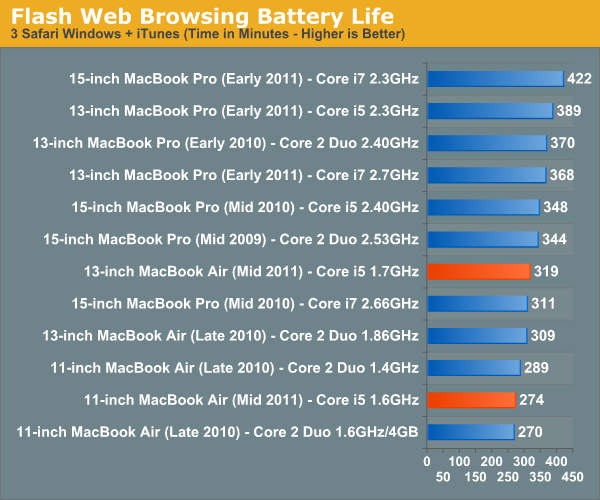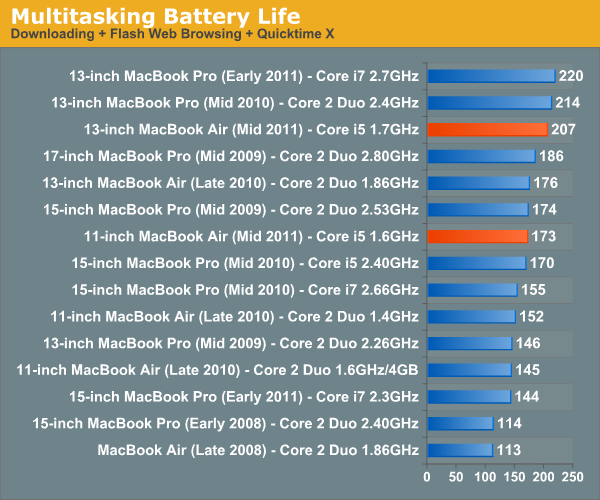The 2011 MacBook Air (11 & 13-inch): Thoroughly Reviewed
by Anand Lal Shimpi on July 28, 2011 3:25 AM EST- Posted in
- Apple
- Mac
- Intel
- Sandy Bridge
- MacBook Air
- Laptops
Battery Life
We've already established that the new MacBook Air lineup is significantly faster than its predecessor, but what does that do to battery life? Interestingly enough with a couple exceptions, not too much.
Let's look at the facts. Last year's MacBook Air used a 45nm Intel Core 2 Duo CPU paired with an NVIDIA chipset. The Core 2 is a very mature architecture that uses very little power under load. The 2011 Air gets the benefits of integration. The CPU and GPU are both on 32nm compared to 45/40nm for the previous generation. On top of that there's also power gating and architectural efficiencies to take into account.
The new Air models retain the same battery capacities as their predecessors: 35Wh for the 11 and 50Wh for the 13. It wasn't too long ago that the 15-inch MacBook Pro only had a 50Wh battery so this new 13-inch MacBook Air should be a good upgrade for users of older MacBook Pros even from a battery life standpoint.
Light Web Browsing
Here we're simply listening to MP3s in iTunes on repeat while browsing through a series of webpages with no flash on them. Each page forwards on to the next in the series after 20 seconds.
All screen savers are disabled, but the hard drive is allowed to go to sleep if there's no disk activity. The wireless connection is enabled and connected to a local access point less than 20 feet away. This test represents the longest battery life you can achieve on the platform while doing minimal work. The results here are comparable to what you'd see typing a document in TextEdit or reading documents.
Last year's 13-inch Air did amazingly well in our light web browsing battery life test, shattering even Apple's own expectations for the system. The new 13-inch MacBook Air doesn't fare as well.

While the new Air still delivers a respectable 6.9 hours of battery life in our lightest test, it's no where near what last year's model provided. If you're used to using your Air as a glorified typewriter, expect less battery life with the new model.
I'm not entirely sure why the 2010 13-inch MacBook Air did so well in our test. It lasted more than 60% longer than the 11-inch Air despite only having a 42% increase in battery capacity. There was something unique about that model that has since been lost.
The new 11 also loses out in the battery life department, but the drop isn't nearly as significant. The new 11 dies about 10% faster than last year's model in this test.
I should add that these results do generally support Apple's battery life claims for the MacBook Air. Apple lists the 13 as having up to 7 hours of battery life and the 11 with up to 5 hours.
Flash Web Browsing
The test here has three Safari windows open, each browsing a set of web pages with between 1—4 animated flash ads per page, at the same time. Each page forwards onto the next after about 20 seconds.
As always, the displays are set as close to one another as possible, audio at two bars, screensaver disabled and the hard drive is allowed to go to sleep if idle. The wireless connection is enabled and connected to a local access point less than 20 feet away.

Our light web browsing test is really the absolute best case scenario for battery life under OS X. I often use the term glorified typewriter because that's typically when you see these numbers: just typing away in a TextEdit window. For a writer, that's a valid usage model but for the majority of the population you'll be doing a bit more. This is where our Flash Web Browsing test comes in to play.
Here the numbers drop and the gap between last year's MBAs and the new systems shrinks to basically nothing. You can get around 5.3 hours of browsing duty out of the new 13 and a little over 4.5 hours from the new 11. Those numbers are near identical to last year's model, telling us that the increased power consumption of Sandy Bridge is almost entirely offset by better integration and the move to 32nm.
Multitasking Battery Life
Our final battery life test is the worst case scenario. In this test we have three open Safari windows, each browsing a set of web pages with between 1—4 flash ads per page, at the same time. We're also playing an XviD video in a window all while downloading files from a server at 500KB/s.

This test is really going to be the number a lot of power users see on a regular basis. Not giving the CPU much time to go to sleep results in very quick battery drain. Higher CPU demands also ensure that Sandy Bridge has room to flex its muscle, giving the new machines a bit of an advantage over last year's models. In a race to sleep, the faster CPU typically wins. If there's never any chance to sleep, the slower CPU usually lasts longer.
The new 13 does very well here, it's in the top 3 barely behind the 13-inch MBPs from last year and earlier this year. The 11 also puts forth a respectable effort, tying the 15-inch MacBook Pro from 2009/2010 and besting this year's model. Note that the 11 is significantly slower than the new 15-inch MacBook Pro, so while it'll last longer you may not be able to get as much done in the same amount of time. But compared to the rest of the systems in Apple's mobile lineup, the new Airs do relatively well under heavy load.
Looking at absolute numbers however the data is less impressive. The 13 is borderline acceptable with its 3.75 hours of battery life, while the 11 is a bit more disappointing at under 3.
The 11 vs. 13
If you're deciding on the 11 vs. 13, here's how the battery life breaks down between the two. On average you're going to gain another 38 minutes of usage with the 13-inch MacBook Air vs. the 11-inch model.
| OS X Battery Life Comparison | ||||||
| Light Web | Flash Web | Heavy Multitasking | Average | |||
| 13-inch MacBook Air | 416 minutes | 319 minutes | 207 minutes | - | ||
| 11-inch MacBook Air | 380 minutes | 274 minutes | 173 minutes | - | ||
| Advantage in Minutes | 36 minutes | 45 minutes | 34 minutes | 38 minutes | ||
| Advantage in Percent | 9.5% | 16.4% | 19.7% | 15.2% | ||
It looks like you'll see anywhere from an additional 10% to nearly 20% battery life from the 13. If we're talking time, the 13 will give you at least another half an hour of battery life from a full charge under OS X.










103 Comments
View All Comments
tipoo - Thursday, July 28, 2011 - link
I'd like to know too, in fact I think a decibel reading for laptop reviews would be great.solatic - Thursday, July 28, 2011 - link
"... [It's] easy to imagine a future where laptops become a lot more like the new Air and shift to a couple high bandwidth ports instead of numerous lower bandwidth connections."I agree in a sense, but I very much disagree with the manner of your idea.
Getting rid of low-bandwidth ports on laptops is stupid because these low-bandwidth ports are industry standards. The standard display jack for projectors everywhere, from business rooms to classrooms etc., is VGA. Good old VGA from the 90's which was never displaced by HDMI or DVI despite their ubiquity and technological superiority. Why is irrelevant, but my point is that I can't tell you how many people I've seen with Apple laptops who time and again have asked to borrow my machine with its VGA port because they can't find their VGA dongle or forgot it at home/the office.
VGA, RJ-45, USB - we don't use these jacks because of how much bandwidth they move but because we know we will encounter devices in the field that will use them.
What you really want, Anand, is a docking station. Lenovo/IBM has/did made/make them for some time for the Thinkpad line. You come to the office, slide your laptop in, and boom - the docking connector is a high bandwidth connector that connects you to network, display, audio, interface, etc.
The only real problem with docking stations is that they're either proprietary (the Thinkpad ones) or they're too slow for higher-bandwidth applications (USB docking stations). If you see a future in Thunderbolt docking station-type devices - like the Thunderbolt display - then this is a good thing. The Thunderbolt display can now be used by any Apple computer with a Thunderbolt port - whereas Lenovo has to manufacture different docking stations for the X and T series and these docking stations can't be used with Toshibas, Apples, Dells, etc.
But to propose getting rid of VGA and RJ-45 ports now is not something I can agree with. Put Thunderbolt on new machines, make Thunderbolt projectors etc., wait for them to saturate the market - and then, only then, does it really make sense to get rid of these slower ports.
repoman27 - Friday, July 29, 2011 - link
It certainly makes sense to ditch VGA on a product like the MacBook Air, since a VGA port is too large to physically fit inside it. And it makes sense on all other laptops since most people would rather have 10 more mins of battery life all the time than a VGA port on the odd occasion that they need one. I propose that those who own archaic video devices lacking a digital interface buy a $5 adapter and leave it attached to the device, that way people with modern notebooks can connect to them without issue.The lack of a wired Ethernet port on the Airs is also due to its ultra slim profile, but it amazes me how many people I know that have no idea that they can plug their laptops into a wired network and get far better throughput. As long as WiFi offers more bandwidth than most people's ISPs, I think you can kiss that RJ45 port goodbye without upsetting too many folks.
Wolfpup - Thursday, July 28, 2011 - link
Great reviews like this are why I love this site. Super thorough and interesting on the tech, and, interesting thoughts on practical stuff too.I prefer Windows, but have been wanting a secondary Mac for a while for the heck of it. I'm SUPER torn on what to get...
The 11.6" almost seems perfect, since I can throw it in my bag with my main notebook and be okay-stick it on my desk without too much issue. But...if I ever actually used it as my primary system, the 13.3" one would be a lot more usable. And at THAT point, the 13.3" Pro is a lot more usable, and at THAT point, the 15.4" Pro isn't much larger, and completely destroys it, and of course could be my main system...
Sooooo you see my dilemma ;)
Heh...maybe I should just go with the 11 since I'm not planning on using it as my primary.
name99 - Thursday, July 28, 2011 - link
"All three parts support Hyper Threading and Quick Sync, although the latter remains mostly unused in OS X. "Quick Sync is used by iChat HD, is it not?
The other natural client for it would be AirPlay. My guess is that, come iOS5 in September, we will see AirPlay on SNB macs beefed up to be able to stream any content (not just h264) to AirPlay devices by doing the transcode transparently on Quick Sync.
The third obvious sort of client would be a library that third party apps like HandBrake would get to. What's the currents situation now --- do you need to be root to get to QuickSync or can any app use it?
My guess is that we are facing the constant problem of new "weird" hardware --- it never comes virtualizable in the first iteration, which means that there is ALWAYS the problem of how to mediate access. And we generally see the same pattern
(a) A single app that is allowed access.
(b) Some sort of library that provides its own mechanisms for mediating access.
(c) The hardware (FINALLY) becomes virtualizable.
Apple is currently at step (a). Getting to (b) is never completely trivial (in spite of the claims of no-nothings in blog comments), at least if you want to do the job properly. You have to consider questions like --- do you use a reservation model, or do you simply provide notifications when you want to grab the hardware away from a user? How easy is it juggle state and provide something that looks virtualized? etc etc.
And there are ALWAYS, at least in the first gen, weird hardware interlocks that make life more difficult. I know nothing about QuickSync but I would not be surprised if, for example, using it has implications for using the main GPU, meaning one more thing that has to be balanced in the attempt to make it used more generally.
Can someone from the Windows world (who understands these issues, and has something more useful to say than "Macs suck") tell us how QuickSync is used in the MS world? Does MS provide a general purpose library, and how does the mediation model for that library work?
name99 - Thursday, July 28, 2011 - link
Oops, my bad. The Macbook Airs apparently do not have an HD camera because it can't fit in the available depth of the thin screen. So no iChat HD on these models.I think the rest of what I said, especially about AirPlay, still stands.
rootheday - Friday, July 29, 2011 - link
The sharing/scheduling of the GPU enginers by multiple client applications on Windows is mediated by the OS as part of the WDDM driver model dating back to Windows Vista - QuickSync is no exception. This means that we are already at c) on your hierarchy on Windows with multiple client applications able to easily share the GPU for encoding.Moreover, Intel has a library already for this - see http://software.intel.com/en-us/articles/media/
The media sdk library provides an API that applications can use to perform encoding and decoding. If run on a system with QuickSync hardware support and drivers, the work is routed to the GPU. If not, the library offers a CPU fall back path. This allows ISVs to write their application once - it will just run faster on Sandybridge systems.
I don't know enough about Apple OS and graphics driver model to comment on how hard it would be for Apple to get to the same level.
jvmxtra - Thursday, July 28, 2011 - link
Thanks for the great review. I throughly enjoyed your review but I feel like one thing is missing.In fact, for a laptop review, I really want all the sites to start devoting some time and even creating a method to measure the heat that laptop brings on. We have to create some type of way to measure(benchmark?) the heat index as I feel like how hot laptop gets under certain circumstance is critical factor.
In fact, I had to trade in my 15 inch mbp since it was just getting too hot.
tipoo - Thursday, July 28, 2011 - link
The thermals and power consumption page is a start.name99 - Thursday, July 28, 2011 - link
"This is what Thunderbolt was meant to do. All we need now is widespread adoption, more accessories and a standard for external GPU form factors."AND device manufacturers who are not idiots. In particular, where are the TB hubs?
The device the market obviously wants is a TB to USB3 hub ---
two TB ports, four USB3 ports --- and yet we still have not seen this.
I'm sorry, Sonnet, but this would be VASTLY more useful than your EN and FW800 bridges.
WTF is going on?